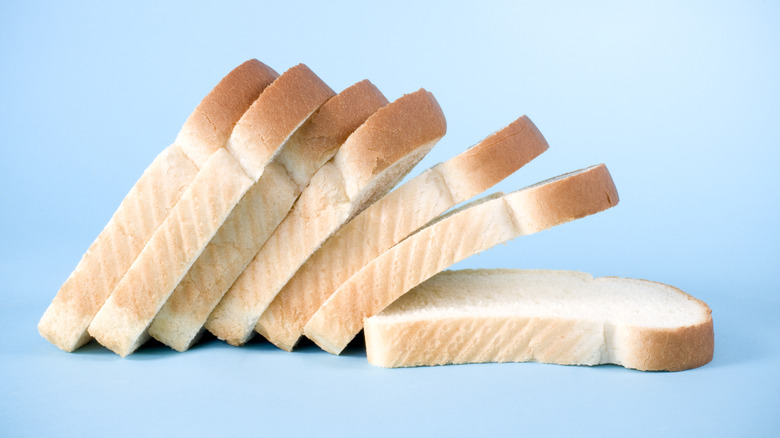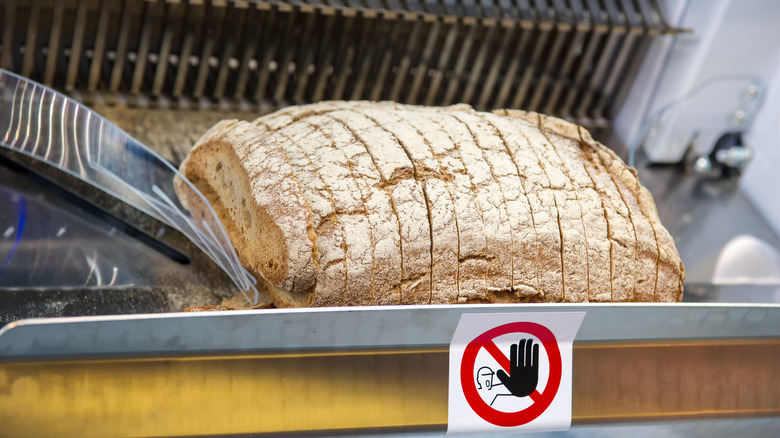The Troubled Origins Of Sliced Bread
It actually took some time before the invention of sliced bread was considered the greatest thing in the world. Looking back on its history, the well-known cliché of "the greatest thing since sliced bread" could well have been "the saddest thing since sliced bread" or even "the most outrageous banned thing since sliced bread." When bread was first created about 30,000 years ago, it was generally torn into pieces or chunks and passed around the table for others to do the same, thus the phrase "breaking bread." The practice remained in place until well into the 20th century when an innovative professional got the idea to create a machine that would cut bread loaves into slices.
You'd assume that the genius inventor cashed in on his invention, bought a private island, and spent his days soaking in the sun, but quite the contrary. There were a few (big) bumps along the way, including convincing the skeptical public that sliced bread was, in fact, a good thing. While we, today, can't imagine our lives without a loaf of sliced wheat or sourdough in our pantries, ready at the drop of a hat (yet another cliché) to transform into our breakfast toast, those who got their hands on the very first pre-sliced loaves weren't convinced of its magic. But once things caught on, they never let go.
A tragic start for sliced bread
Otto Frederick Rohwedder was a trained ophthalmologist and jeweler by trade but he also liked to invent things. He became so intent on creating a bread slicing machine that in the early part of the 1900s, he sold all three of his jewelry stores to get the capital he needed to build a prototype for the machine. But in 1917, he suffered a devastating loss and setback when his factory caught fire, destroying his prototype, plus the blueprints for it. But, of course, (cliché alert!) all good things come to those who wait and for the next decade, Rohwedder rebuilt what he'd started.
By 1928, his invention went beyond a machine that could just slice bread; it also wrapped the bread loaves. After patenting his machine, Rohwedder sold it to Missouri-based baker Frank Bench who began selling sliced bread. Rohwedder sold an additional machine to Gustav Papendick who made improvements to it that kept the bread fresher for longer. He eventually sold the patent rights themselves to the Micro-Westo Company of Iowa, but he actively led the company's Rohwedder Bakery Machine Division which sold his machines to many more bakeries.
More bumps in the road
Despite the vast availability of pre-sliced loaves of bread, customers weren't exactly sold on the concept right away. Many believed the loaves looked downright sloppy and were concerned that the fresh loaves would turn stale faster than they could eat them due to the bread already being cut. An article in the Chillicothe Constitution-Tribune published in July 1928 significantly helped turn the reputation of sliced bread around when it praised the concept, noting that the neat, precise slices simply couldn't be replicated by hand. By 1930, sliced bread was widely available all across the country with most families opting to purchase it rather than make their own.
By the time World War II arrived, sliced bread was an American pantry staple. Imagine people's surprise in 1943 when the government banned factory-sliced bread in an effort to save resources for the war effort. For the most part, American patriotism was high during this time, and families were willing to sacrifice things like sugar and meat for their men and women overseas. But they drew the line at sliced bread and created such an uproar that the ban was overturned just a few months after it was put into place.
Today, sliced bread is so widespread, it's probably harder to find unsliced bread than it is sliced bread. In less than 100 years of bread's 30,000-year history, a slicing machine changed the way we eat our carbs, likely forever.



